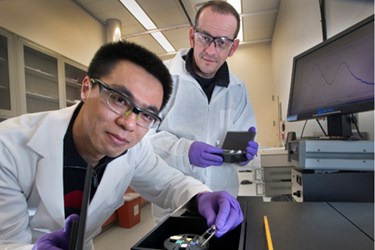Researchers Develop Inexpensive Fluorescent DNA Sensors
By Joel Lindsey

Researchers at the U.S. Department of Energy’s National Laboratory and Stony Brook University have devised a way of using an inexpensive fluorescent dye to conduct effective DNA analyses.
“The sensors we’ve developed use a light-absorbing polymer to amplify the fluorescent signal of a dye that emits light only when it binds between two matched pieces of DNA,” Mircea Cotlet, a physical chemist at Brookhaven’s Center for Functional Nanomaterial, adjunct professor at Stony Brook University, and lead researcher on the project, said in a press release published recently on Brookhaven’s website. “This system is sensitive enough to detect individual mismatches between the bases that make up the ‘rungs’ of the twisted-ladder DNA double helix molecule, making it highly specific with no false positives.”
According to the press release, Cotlet’s team is not the first to try analyzing DNA with the help of fluorescent dye, but there are novel aspects to this approach that make it a major advance.
“The dye we use is hundreds of times cheaper than popular commercial intercalating dyes,” said Zhongwei Liu, a graduate student at Stony Brook University involved with the project. “When it inserts itself in the grooves of the DNA, the dye becomes fluorescent. And so far it is the only dye that can intercalate so densely with DNA — meaning exactly one dye molecule binds between each complementary base pair of the DNA double helix.”
The researchers then applied a conjugated polymer with a natural proclivity to bind with the DNA strands, which helped to amplify the amount of light absorbed and emitted by the fluorescent dye.
After a strand of DNA has interacted with both the fluorescent dye and the conjugated polymer, it can effectively be identified by how fluorescent it is. The fluorescence profile of a tested DNA molecule can then be compared to those of known DNA molecules as a way of identifying an unknown substance.
While this technique could be applied to a variety of different applications, researchers involved with the project have indicated that, because the technique is quick, inexpensive, and effective, it could provide an affordable and highly mobile way to conduct medical diagnostics in the field or in economically underprivileged areas.
Details regarding the project are provided in an article published recently in the journal Chemistry of Materials.
Image Credit: BNL
